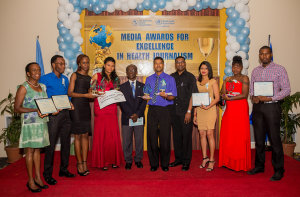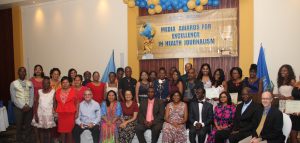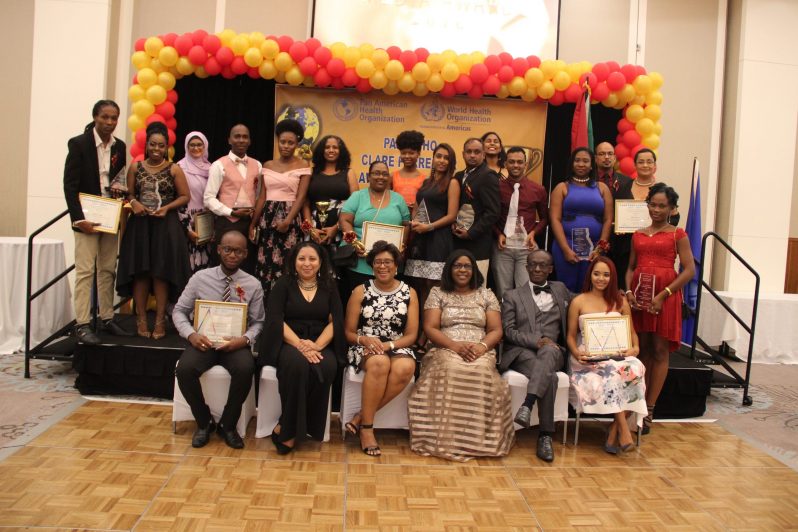SIX years after it was reintroduced to Guyana, the Clare Forrester PAHO/WHO Media Awards for Excellence in Health Journalism has certainly raised the standard of health reporting in the country. It has resulted in increased awareness about Communicable and Non-Communicable Diseases, health policies and issues plaguing the local health sector.
It was Dr William Adu-Krow who resuscitated the awards in December 2014, months after he had presented his Letters of Credence to the Government of Guyana accrediting him as Pan American Health Organisation/World Health Organisation (PAHO/WHO) Country Representative. Prior to 2014, the awards were held biennially from 1990 to 2008, giving due recognition to some of the country’s best writers such as Melanie Allicock, Ruel Johnson, Oluatoyin Alleyne, Iana Seales and Shirley Thomas. Cognisant of the role of the media in safeguarding the health of the nation, Dr Adu-Krow made the awards an annual feature as was done in the past by his predecessors.
“The media plays an important role in highlighting public health issues and is a strong tool for advocacy, communication and education,” Dr Adu-Krow had said in 2014 when he delivered his address during the first Clare Forester PAHO/WHO Media Awards held under his watch. “In Guyana, we are challenged with the increase in communicable and non-communicable diseases such as Chikungunya, Malaria, and Mental Illness including Suicide; also, Hypertension, Diabetes and many other diseases. These diseases and their contributing factors must be highlighted to get the attention of all stakeholders for them to take action, for prevention and control of these diseases in order for us to address the social determinants of health and have a healthy society. The media is well positioned to disseminate health information and raise awareness about public health issues,” Dr Adu-Krow had said.
Initially focusing on the traditional media – radio, print and television – the awards have evolved to include multimedia, and span a wide range of topics. Offering her analysis, Behavioural Scientist and Chief Judge Professor Dr Paloma Mohamed, said the awards have enhanced health coverage in the country by the local media.
“Clearly, the PAHO media awards have greatly improved the visibility, number, diversity and quality of health reporting in Guyana. When we assess also the number of media houses who have assigned health beats to journalists and the number of column inches in print media, in particular, allocated on average, we might be looking at a 30-40 per cent increase in coverage over the last five years; this is significant,” Dr Mohamed told the Pepperpot Magazine.

In acknowledging the work done by Dr Adu-Krow and his team at the PAHO/WHO Country Office in improving health journalism in Guyana, Dr Paloma said in addition to the awards, the health organisation has facilitated greater access to information, conducted ‘brown bag’ lunches and panel discussions on topical health issues, and held a number of workshops targeting both editors and reporters.
“I really think that we began to design the awards as a developmental process of strengthening the local media corps in every way,” Dr Mohamed said, while adding that the comprehensive chief judge report, produced annually, includes recommendations for enhanced health reporting. It was based on those reports and more so recommendations, that PAHO funded training on online and multimedia journalism, in addition to the other informative sessions.
Dr Mohamed has been the Chief Judge for the awards since 2015, judging alongside radio and television personality Russel Lancaster; Director of the Centre for Communication Studies at the University of Guyana, Nelsonia Budhram; Dr Vasha Bachan and Volderine Hackett.
For journalists, the Clare Forrester PAHO/WHO Media Awards for Excellence in Health Journalism present an ideal opportunity for them to gain recognition for the work they do in raising awareness and influencing change on all matters pertaining to health.
“PAHO has played a meaningful role in encouraging and celebrating outstanding works in journalism. This has helped many reporters to gain public recognition and encourage many more to write about health. In doing so, the awards have succeeded in raising awareness of a multitude of health issues reaching a diverse audience,” Tajeram Mohabir told the Pepperpot Magazine.
Mohabir, a News Editor at the Guyana Chronicle, was the overall winner of the 2014 Clare Forrester PAHO/WHO Media Awards for Excellence in Health Journalism. Additionally, he was the winner of the Best News Story Award and the second-place winner of the Best News Feature Award. Since then, Mohabir has received more than 10 awards from PAHO/WHO, the United Nations (Guyana Office) and the Guyana Press Association.
For Mohabir, who, despite being an editor, sees himself as an active journalist, said the PAHO Awards have given him a greater appreciation for research and healthy living. “Personally, there are two standouts about the awards. One, through research, I got to understand the importance of things like eating healthy, exercise and yoga in health and wellness; and two, I was able, through my writings, to support efforts nationally aimed at ensuring a healthy population,” he explained.

Though she is no longer a journalist, Shivanie Rampersaud said she is pleased to have made her mark before exiting the media fraternity. Rampersaud and Tajeram were among the few journalists who had participated in the PAHO/WHO media awards in 2014. In the case of Rampersaud, she received two awards: one for her reporting on Chikungunya. In 2015, Rampersaud gained third place in the awards for a feature she had done on the National Public Health Reference Lab.
“I remember doing a feature on the National Public Health Reference Laboratory (NPHRL) and the services they offered, only to have someone say to me that the piece provided them with information that they were never privileged to. The piece went on to win third place in the online feature category that year, and I’m glad it was impactful,” Rampersaud told the Pepperpot Magazine.
In 2015, Kaieteur News’ Desilon Daniels copped the overall award after raking in several awards in the print and online categories. According to the Chief Judge’s Report, a total of 78 submissions were made that year with 48 from print alone, three radio, two television and 21 online entries. Daniels is currently studying in the United Kingdom. She is among 11 Guyanese who were awarded Chevening Scholarships this year.
In December 2016, the Guyana Chronicle’s Svetlana Marshall was honoured by PAHO/WHO after being adjudged the overall winner of the PAHO/WHO (Guyana Office) competition for Excellence in Health Journalism. However, she had received her first award in December 2015 after one of her many articles, “Enough not being done for ‘sicklers’ – says victim, Dr Norton pledges gov’t support,” emerged as the best News Feature Article for the PAHO/WHO Health competition that year. In 2017, she also dominated the PAHO/WHO Health awards. To date, Marshall, who is now an Assistant Editor at the Guyana Chronicle, has won a total of nine awards during the three years she participated in the competition. Notably, it was after winning her first award that Marshall was allowed to collaborate with the Guyana Nurses Association to produce her first magazine – “Nurses in Guyana 1966-2016: Reflection, Celebration and Inspiration.” In 2018, she became a U.S. State Department International Leadership Visitor Programme (IVLP) fellow.
Twenty-year-old Vishani Ragobeer was just 18-years-old when she entered the competition in 2017. That year, she won the Best Online Feature Story Award and a Special Award for the Best Coverage of the Mass Drug Administration Campaign of Lymphatic Filariasis. Additionally, the Guyana Chronicle Freelance Journalist placed second in the Best News Feature (Print) Category.
Ragobeer, who is now studying at the University of the West Indies (UWI) St. Augustine Campus, in 2018 won the Best Online Feature Story Award and a Special Award for the Best Coverage of the Mass Drug Administration campaign for Lymphatic Filariasis. Known for exceptional stories, Ragobeer, who just months ago copped the GPA’s Young Journalist of the Year Award, attributes her success, in part, to the training offered by PAHO/WHO.
“I believe that the training I received from PAHO has allowed me to garner more practical skills and improve not only my writing, but the ways in which I create content for readers. Reporting on health journalism, in my opinion, requires a great degree of diligence, particularly if you are edifying the public on a matter that should be important to all of them– like the MDA for Lymphatic Filariasis, for example. And it was because of the very first PAHO training I attended in 2017 that I became very keen on this MDA (which was restarted in that year) and using my work to educate the public on why they should be part of it,” Ragobeer told the Pepperpot Magazine.
She added: “Since then, I’ve become so immersed in Lymphatic Filariasis and the MDA that I make it my duty to provide in-depth coverage of this each year when the annual round of the MDA is initiated.” Ragobeer noted too that the skills and knowledge garnered during training conducted by PAHO/WHO, are also applied to her general work, not just in reporting on health.
“Aside from that, a major area of growth and development for me has been the digital media/ online component of the training sessions. A few years ago, online journalism was just something I was fascinated by, but now I can say I believe I have a fairly good grasp on how to tailor my stories for the online platform and how to add various media elements to make my story much more impactful in this contemporary medium of reporting and reaching the target population,” she explained.
For Broadcast Journalist Handell Duncan, the award is a stepping stone to where he wants to be in the field of journalism. “Every training I attended brings about positive changes to the way I do my work, even the conversations on the sidelines of the training helps me. Journalism is a part of my DNA. I am always looking at opportunities to better my craft. I am nowhere where I want to be in this profession; I am always listening and seeking to make adjustments not only to stay relevant, but to see a better health care system locally,” he told the Pepperpot Magazine.
Duncan, who hails from the Pomeroon and has become a household name in the capital city Georgetown, has been entering the competition since 2014, and though he won several awards, it was not until 2018 that he was adjudged the overall winner of the PAHO/WHO Awards for Excellence in Journalism. In total, Duncan won seven awards in the television and radio categories. The HGP Nightly News journalist said, for him, winning an award is just the icing on the cake, but effecting real change is paramount.
“I remember covering a story relative to a young man who needed a liver transparent[sic], the story helped him to get the transplant and when he returned from India where it was done, we talked again. But months later he died. That really impacted me and serves [sic] as an encouragement to keep telling stories with the hope of making Guyanese more health-conscious,” he told this newspaper.
This year, Evening News Editor Devina Samaroo and Guyana Chronicle’s Senior Reporter Vanessa Braithwaite are among finalists for the 2019 PAHO/WHO Media Awards for Excellence in Health Journalism. Samaroo and Braithwaite have won a number of awards since entering the competition in 2016.
“This year, I was nominated in three categories but for two stories (one story was done for both online and television). The first story is about access to abortion care in Guyana. I was inspired to do this story based on conversations I had with friends and colleagues, and it dawned on me how taboo the topic of abortion still is. So, I did some research and realised that access to abortion services in Guyana is very limited, mainly because not many people talk about it,” Samaroo shared.
She added: “Persons are scared to even ask, because of the stigma attached to getting an abortion; so, I wanted to do a story to mount pressure on the authorities to make it more accessible and to show women the dangers of an unsafe abortion, so they can be encouraged to get it done safely, if need be.” Outside of the awards, Samaroo said she writes stories with the anticipation of influencing decisions at the policy level and as well as behavioural change at the level of the regular man in the street.
In the case of Braithwaite, she has written extensively on Toxmoplasmosis, Teenage Pregnancy, Lymphatic Filariasis and Air Pollution, among others. Like Samaroo and the other journalists, Braithwaite, who was GPA’s 2018 Young Journalist of the Year, said she is pleased to be a change agent.
“I am confident that my stories have been very impacting because I learnt that several other health facilities would have adopted a teenage antenatal clinic to help these teens cope with the extra challenge of carrying a child, at a very young age. Ronella, the mother of the children who were visually impaired has since received overwhelming support from both civilians, corporate society and medical facilities. PAHO/WHO, in collaboration with the Ministry of Public Health has also romped up its sensitisation campaign against stigma and discrimination, which no doubt has played a major role in educating the public about the support they should give to those suffering from the disease,” Braithwaite told the Pepperpot Magazine. Since 2015, the Guyana Chronicle has dominated the awards and has been recognised by PAHO/WHO as the media outfit with the most winning entries. This year, more than 100 entries have been submitted for the awards from across media houses.
Looking ahead, the Chief Judge believes that journalists would do even better if they widen their coverage of health-related matters. “With regard to the specific field of health, accuracy and more in-depth knowledge of some of the technical areas of the fields of coverage can be improved. There are mental health and ecological interactions with natural environmental factors and social factors with health, which are so far generally neglected. For instance, some health journalists may have begun to think about how changing climate affects health or violence as a health concern or oil and gas as a driver of changes in lifestyle,” Dr Mohamed explained. She said it is important to be analytical rather than descriptive when reporting on critical issues.
Weighing in on the matter, Lancaster, who is among the judges, said that while there are some exceptional writers, there are others who are in need of help, particularly in news and feature writing and multimedia reporting. He said from all indications, some reporters do not know the difference between a news story and a feature story or the difference between a newspaper story online and an online or multimedia report. He was keen on noting that in addition to texts and photographs, online or multimedia reports feature hyperlinks, charts and graphs, interactive maps and even videos. Turning his attention to radio and television stories, Lancaster said some reporters have not learnt just yet how to maximise the use of the two media.
“If you are going to concentrate on a medium, you really need to understand its possibilities. Print is a visual medium, but you have it with you, so we could afford to write long stories that really go into a lot of detail…Radio is about your ears, so I want to hear different sounds, I don’t want to hear one voice for the entire thing, I want to hear vox pop with somebody that you interviewed, I want to hear the ambient sound in the background, I want to hear some traffic if you are out on the road…Television on the other hand, is very visual and it’s moving visual, so I don’t want still shots, leave the still shots for the newspaper where they can’t move; in television, it’s about moving shots because it is about moving medium,” Lancaster explained. He also urged that editors pay greater attention to the reports produced by journalists, noting that too often there are grammatical mistakes and inaccurate information embedded in reports. The PAHO/WHO Awards are named after Clare Forrester, who was the Media and Communication Adviser with PAHO, serving in both Jamaica and Barbados.



.jpg)









